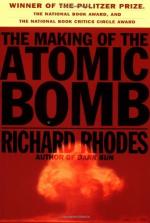|
This section contains 378 words (approx. 1 page at 400 words per page) |

|
Chapter 6 "Machines" Summary
With Sir Ernest Rutherford's as Director, the Cavendish Laboratory at Cambridge, England, becomes the center for experimental physics after World War I. There, in 1919, he announces that he has split the atom. Rutherford and his co-workers disintegrate other light atoms until they hit a barrier -- the naturally radioactive sources. Americans develop particle acceleration at Berkeley, California. Ernest Orlando Lawrence, the man, who later founds big-machine physics in America, comes to Berkeley in 1928, one year before Robert Oppenheimer. They know that protons can be accelerated by generating them in a discharge tube and then repelling or attracting them electrically, but they cannot confine the million volts of electricity necessary to penetrate the electrical barrier of the heavier nuclei. Norwegian Rolf Wideroe invents an accelerator tube that will avoid the high-voltage problems. Lawrence calculates the size of the tube he...
(read more from the Chapter 6 "Machines" Summary)
|
This section contains 378 words (approx. 1 page at 400 words per page) |

|




